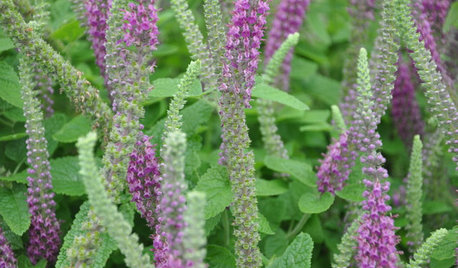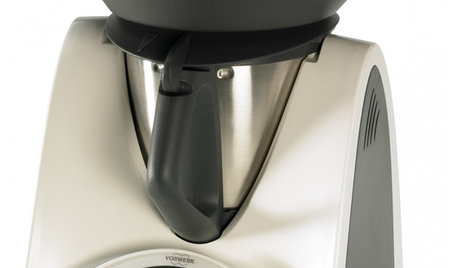But has anyone actually EATEN hyacinth beans?
I've been reading the posts, and researching online, to determine whether it's safe to eat the beans on my purple hyacinth bean vines. I'm finding information that goes both ways - safe, unsafe, safe if you cook twice, safe if not dried, etc. etc. Has anyone actually made it a habit to eat them? I'd feel a lot better about eating them, myself, if I knew that someone else has eaten them without incident.
Comments (45)
marshallz10
19 years agoI am cautious and would not eat them. I am growing both the purple and the white hyacinth types; the purple very beautiful in flower and fruit. The white is said to be less poisonous than the purple, for what that's worth.
stefoodie
19 years agosee my post above:
i've eaten them, but i'm not convinced they're the same hyacinth bean
Related Professionals
Edmond Landscape Contractors · Franklin Landscape Contractors · Longmont Landscape Contractors · Madera Landscape Contractors · Mason Landscape Contractors · Placerville Landscape Contractors · Soddy Daisy Landscape Contractors · Southbury Landscape Contractors · Birmingham Carpenters · Horsham Carpenters · Odenton Carpenters · Wrentham Carpenters · Derry Siding & Exteriors · Hamden Siding & Exteriors · Saint Charles Siding & Exteriorskatzeyes75
19 years agoI have eaten hyacinth beans. On Halloween this year, my friend and I decided we'd finally try them. We steamed them for about 45 minutes. The color pretty much drained and left them limpid and greyish. We added butter, salt, pepper, and a hint of garlic powder to them. They tasted like a cross between a green bean and a mushroom to me. Not really sweet, but, a very nice flavor. Unfortunately for me, the color of the beans put me right off them. I am a person who cannot eat something if it's not the right color. A strange quirk, yes, but, to me, beans are supposed to be green, not greyish purple. So, I guess if I could get passed the color issue, I'd eat them again. They really are tasty.
gardenalive
19 years agoI tried a couple after boiling them in hot water for 30 minutes. To me, they taste pretty to lima so FWIW, i'd rather be on the safer side and stick with the limas although I am less afraid to try hyacinth now.
fireflyintexas
19 years agoI have eaten the flowers and have read that they are edible as well as the bean.....they have a true beany flavor. Very good. I guess they could be used to dress up a salad, much like pansies, violas, and nasturtiums.
I had never heard they might be poisonous.
fireflynataliep
19 years agoI eat them all the time. They get too tough/fibrous if you let them grow old, but otherwise Ok.
bigeasyjock
19 years agoI had tried them when the pods were young (without beans) like a snow pea. 'Course I didn't know any better at the time ;o) They by the way were very tough and we didn't eat them after just a couple. Lucky me !!!
I have since read about them being toxic.
MikeEuphoria526
19 years agoI've read that Thomas Jefferson grew and ate them regularly at his garden. I think it was in an article by southern living, although i'm not sure.
carol_the_dabbler
19 years agoI just read about hyacinth beans (Lablab purpureus, also known as Dolichos lablab) on pages 234-5 of Larry Hodgson's 2002 book "Annuals for Every Purpose."
I have just spent half an hour trying to include a link to the Amazon page for this book. Even though I have never had any trouble creating links on this forum before, it keeps losing my "Name of the Link" and insisting that I fix it, then losing it again. I give up -- just go to www.amazon.com and search for "Annuals for Every Purpose" in Books.
Hodgson's comments may clarify the edible/toxic debate: "...hyacinth bean is a staple vegetable ... throughout much of Asia and Africa. All of its parts are edible; you can even eat the young leaves, lightly steamed...While the seed is still small and soft, eat the pods raw or cooked; once the beans are mature, cook and eat them fresh, sprout them, or dry them for future use. THROW AWAY THE COOKING/SPROUTING WATER, THOUGH, SINCE SOME PEOPLE ARE ALLERGIC TO IT [emphasis added]."
And no, I have never eaten them myself.
breezyb
19 years agoHmmm - does anyone think it could be that they're only poisonous/irritating to certain people? Like Fava beans, which can cause allergic reactions to folks of Mediterranean origin?
carol_the_dabbler
19 years agoIt certainly sounds like that's what Hodgson believes. And it would explain why some sources say they're toxic while others say they're wholesome.
It would be interesting to know *why* each side says what they do -- is this another case of "everybody knows" or is it anecdotal or have any studies been done? (Hodgson does not name his sources, by the way. His book was printed by Rodale, so he may have used their resources.)
WestEnder
Original Author19 years agoIt's interesting to me that this posting continues to generate interest. Whether to eat hyacinth beans must be one of the great gardening questions of our time.
Just to follw up, I did eventually eat my hyacinth beans this past summer. I started with just a handful in a pot of lima beans, then graduated to a full pot of nothing but hyacinths, which I cooked and drained more than once before comfortably eating. Hyacinth bean vines are very prolific, and seem to be disease-resistant in my yard here in Atlanta, so I really wanted to be able to eat them.
However, I have concluded that the beans aren't worth the worry and bother. Cooking and draining multiple times is a hassle, but I felt I should do it to be safe. The texture and taste of the hyacinth bean wasn't that great, in my personal opinion. I do prefer lima beans, which have a more meaty texture and, I think, better "mouth-feel." I did not like the combination of hyacinth and lima beans in one dish, although I think field peas and limas mix well together.
I really appreciate everyone's contributions to this post. It was reassuring to hear from people who had actually put the darn things into their bodies - and lived! I had no ill health results after eating them, either.
greenwitch
19 years agoPlease see my thread link below.
This morning I steamed the beans for around 7-10 minutes (until tender when pierced with the tip of a knife). I didn't even butter or salt them, just let them cool a bit and ate them with my fingers - delicious! The only drawback is the strings on both sides of the pod, but they're easy enough to remove. I'm definitely finding a place in my garden for these.
Here is a link that might be useful: Bangladesh flatbean -
greenwitch
19 years agoLooks like they're popular in many parts of Asia. Maybe it would be prudent to grow a KNOWN culinary strain for consumption.
Here is a link that might be useful: Three strains of hyacinth beans
Dino_Tsapatsaris
19 years agoI am an expert on edible wild plants, which the dolichos lablab is not in per se in America. I have not eaten the hyacinth bean. However from my library....on page 256 of Edible Wild Plants of Eastern North America by Merritt Fernald and Alfred Kensey they report:
"The ornamental hyachinth bean, with showy purple or white flowers in long and interrupted spike-like clusters and large pods about one inch broad, is cultivated chiefly for ornament southward and has escaped to roadsides and thickets northwards to the District of Columbia and Ohio. In the Far East, where it is native, the young foliage, tender young pods and fresh inflorescences are eaten either raw or steamed, while the beans are cooked.
kohoutekdriver8
18 years agoI purchased seeds at my garden club's recent plant sale, and the seller said they are edible, that she prepares the immature seed pods like snow peas.
From the other posts, it looks like the beans - green or shell - must be cooked before being eaten, and that they shouldn't just be picked off the vine and eaten in the garden the way I do with asparagus.
BTW, the fava bean reaction is not a true allergy. Some people of Mediterranean or black heritage have a condition called G6PD, which is a deficiency of an enzyme that protects the body against some toxins, including one found in fava beans. It causes hemolysis, which is the destruction of red blood cells.
bigeasyjock
18 years agoAs an added note after speaking with Dan Gill of L.S.U. Ag he said ALL beans contain a poison but with cooking this poison becomes ... not a poison ;o)
Cook LabLab like any other bean or as a snowpea when very young (I had waited to long I was told thus the tough seed cases). Dan said he had consumed many a lablab bean to no ill effects. Oh and I believe this guy. Smart as a whip he is ;o)
Mikespeng1979
18 years agoI had stir-fried some yesterday and they were delicious. I did not boil the beans at all.
nosyrosie
18 years agofyi-I had a hyacinth bean growing like gangbusters this summer, and I decided (after much research) we ought to eat some, in a spaghetti sauce that included parsley and little yellow tomatoes I also grew.
I thought they were disgusting, actually, as did my daughter; my husband and son with great fortitude thought they were "okay." I am going to try scarlet runner beans next time.
Rose
sharna
18 years agoI never would have dreamed they were thought to be poisonous. We've grown and eaten the purple (dolichos lab lab) and I think there is a white. We regularly ate them and I agree stir fry of young beans would be one of the best methods. certainly not boiled. Young pods, like 1 1/2" max lightly steamed. Another marvelous bean I think is called an asparagus bean. It prodices beautiful sky blue flowers, I believe these to be edible also and ruffled 4 sided beans. Think of a cross section like a four sided star. Again very young beans, 3" or less, steamed, or stir fried. If grown with the hyacinth white and purple on a sturdy teepee like structure the flowers are gorgeous. Or any sturdy shape for bean vines that grow to about 8 feet.
Bob (Seattle, Zone 8a)
18 years agoI asked this question in a food forum, and got a very good answer from someone from a country where they are regularly used. First, my question, which was:
"So they use hyacinth bean there. I grow it every year and have heard that it is edible but requires some sort of processing before it's safe to eat. Information I've found on the internet seems to conflict, so it would be good to hear it from someone who actually has cooked and eaten it and is here to tell the story. ;)"
The answer:
I think the conflicting information is due to there being slightly differing varieties, as well as the fact that they can be eaten as a green vegetable or as a dried bean. If I remember correctly - and don't eat the dried beans on the basis of what I'm saying without further checking - the green podded variety are okay to eat dried without further processing, whereas the purple podded variety have a greater concentration of toxin in the dried mature beans, and it is these which be processed before consumption.
"My understanding is that ALL the types can be eaten without qualms as a green vegetable. It is only when the pods are older and are mature that toxins are a concern in certain types.
Hyacinth beans in the young, green vegetable stage are sold and eaten in India all the time (known in Hindi as sem, papri, papdi, or val/valor depending on region, type and transliteration conventions). I would actually go as far as to say that they are the most common type of green bean for sale in the markets (in Delhi at least). When most cookbooks in India talk about 'green beans' or 'broad beans' it is actually hyacinth beans they are referring to.
So I can certainly chime in here and say that I've cooked and eaten it on plenty of occasions, and have lived to tell the tale.
They are sold and eaten as a green vegetable when between one inch to about two and a half inches or three inches long. There's a picture of papdi/val (at the link below). Sem are a little flatter, and are slightly undulating.
Here is a link that might be useful: Papdi, Seeds of India
hayremom
16 years agoI can buy hyacinth beans, called val papdi, in the frozen food section of our local supermarket. Of course, there are a lot of Indians in this community. Guess they're edible.
zeedman Zone 5 Wisconsin
16 years agoThis topic has been often discussed on both the Bean Forum & Veggie Forum, as well as several others.
According to the NCSU Poisonous Plants database, raw limas are even more toxic than hyacinth beans (look up "Dolichos lablab" & "Phaseolus lunatus"). It ranks H.B. as "poisonous in large quantities", while limas are "potentially fatal". Even the mature seeds of snap beans are poisonous, if eaten raw. A great many edible legumes are poisonous to some degree, if eaten at certain stages, certain plant parts, or if they are improperly prepared.
The poster which referred to cultivated varieties may be on to something. In this country, hyacinth bean is most often offered in a generic form, for use as an ornamental. In tropical Asia, where they are more widely grown, there are many cultivars bred for their use as a vegetable. These may contain lower levels of toxins than their less-domesticated counterparts. Sadly, they are rather hard to find seed for here, though I have seen a few.
There is also the question of the culture that surrounds them. If one grew up eating hyacinth beans, the methods of preparation would be second nature... in cultures unfamiliar with their use (such as ours) that knowledge would be lacking. We take it for granted in the U.S., for example, that mature bean seeds (butterbeans) should be cooked, because that is what we have always done. In Europe, however, where favas are routinely eaten semi-raw, this is not the case... and some are poisoned each year by eating mature bean seeds the same way.
I have eaten the young hyacinth beans in their "snow pod" stage. The green-podded are very flat, but they were tasteless, and I did not find them to be especially pleasant. The purple-podded are thicker, fleshier, and better flavored. They were very similar in flavor to snap beans, so in tropical areas too hot for snaps, they could be a suitable substitute. Keep in mind, the named Asian cultivars (as opposed to the generics which I tried) may possess superior flavor.
Here is a link that might be useful: NCSU Poisonous Plants database
ktummala
16 years agoHi,
The Hyacinth beans are edible.Does anyone have the white hyacinth bean seeds? iam looking for those for a long time.
Thanks
Kishforever_a_newbie_VA8
15 years agoThe Hyacinth beans are edible but you had better try the new varieties meant for eating. Not the normal oriental haycinth beans, although they are still edible.
The normal haycinth beans have purple flowers and produce dark purple or red bean pods. They bloom and produce beans in summer and very productive. I grew a couple plants 6 years ago and after getting and serving pound a day for a few weeks the family sreamed very hard and we stopped growing it. The bean pods, however early you pick them, tastes quite tough.
This year we grew 2 new types. One blooms the light purple flowers and produces green pods of a light purple or grey tint, and purple string at the sides. The other one blooms the white flowers and produces smaller light green pods.
Both types bloom and produce starting from late summer and reach peaks in the autumn. But neither of them is so productive as the normal type we had before. But they taste so much better and tenderer. I like to slice them to thin stripes and stir-fry (saute) them. You can also put the stripes in boiling water for a minute or two. The beans immediately change to a bright green and look rather appealing.
I've included a link about these variaties. It is in Chinese but you can look at the pictures. Although they are meant for eating, they are as beautiful as the normal oriental type. The only drawback is they kick in later and might not do too much in the summer. But this can be considered an advantage to cover you for the late fall, when there are not so many vegetables growing around.
Here is a link that might be useful: haycinth beans for food (pictures)
tickss
13 years agoi ate this bean on 10/5/10 i at it raw and i dont if i should do anything about it i do feal a little diferent but i think i am just paronyed from what i have read. is it safe or should i get it checked
menonlovedale_gmail_com
12 years agoThe Hyacinth bean is actually an essential part of the diet of the people of Batangas province of the Philippines. The beans contain the toxin HCN (hydrocyanic acid) which is actually a weak cyanide compound. The residents of Batangas cook it with the pot open and after the bean pods are spliced open so as to release the HCN gas and render the dish a little safer to eat.
teddyrockspin
12 years agoIt's safe to eat but don't let them dry. They tend to be very gaseous lol. If you have arthritis might make it worse. Other then that enjoy!
dew80
12 years agoHyacinth bean is eaten very commonly in India but the variety available there is the one with white flowers. I ate hyacinth beans all the time while growing up in India. Here is one of the few ways it is cooked. You'll need to buy some spices from the indian grocery store or you may find some at the Whole Foods or similar store too. Chop some beans, about a pound, and a small size potato into a about 1" cubes. Heat a pan and add a tbsp of oil ( any oil). When the oil is heated add a teaspoon of cumin and a pinch of asafetida and immediately add the the chopped vegetables. Cumin will burn fast so it is important to add the beans in like 5 seconds to the pan with the sizzling cumin. On the veggies sprinkle a teaspoon of turmeric, some red pepper powder, a tsp of coriander powder and salt to taste. Add a couple of tablespoon of water so that the beans dont burn and stick to the pan. Stir. Cover and cook on low to medium heat. Check and stir the veggies periodically and if it is sticking to the pan add 1-2 tbsp of water or simmer the stove. Check a potato piece by cutting into it with the spoon. If it is soft and cuts easily then the beans are cooked too. When the potato is almost done add a chopped tomato and cook for another 5-10 min till the potato and tomato is soft/cooked. Tomato is optional. You may also add a very small amount of freshly squeezed lemon juice before serving specially if you don't use tomato, to give it a bit tangy flavor. If you want to use tomato remember not to add it in the begining as it will take longer for the beans and potato to cook. In the spices if you don't find asafetida it is not going to make a huge difference, you can cook without it too with rest of the spices. Other ways to cook the beans are cooking without potato OR add onion OR add garlic.
theodosiaunderwood
11 years agoLast year I bought a pound of hyacinth bean seeds from a very large ethnic grocery store in Indanapolis. They were from Africa (I can't remember the African name). I sowed them along with my corn and have never had huge vines....much more growth than any other hyacinth bean I've ever grown BUT absolutely no flowers. I have since done some research and found that some varieties are day-lenth sensitive. I assume that was my problem. I live in zone 5 (NW Indiana).
Sylmardal
10 years agoYes - Eat the pods before the seeds get big inside.
De-string the pods, stir fry till color changes, pour in half a cup of water and cover allowing beans to steam.
Discard any water if left over. Eat as side dish or...
Cook with eggs and onion as an omlet, or add to lima bean soupJason Weigner
8 years agoSo to the comment above about being safe and eating lima beans instead, lima beans are not any safer, they are toxic as well if not cooked. They have a compound that turns into cyanide when eaten raw. Red Kidney beans are also toxic unless cooked. I know people get nervous about new foods being "toxic" unless prepared properly there are quite a few foods you have probably eaten that are the same way. Lablab beans have been eaten by other cultures for a long time. Just cook and toss the water. Here are a few other toxic foods!
http://www.huffingtonpost.com/2013/10/04/foods-that-could-kill-you_n_4039765.html
rikki_t
6 years agoI know this is an old thread, but I found it so I'll add my two cents. My grandmother, a very wise cajun woman, only cooked the tender leaves and new pods from hyacinth beans. She only let enough pods mature to replant the next year. She told me that lablab beans and dandelions were just too much trouble to eat, because of all the boiling and pouring off of water. She also told me her brother ate a lablab beans raw once when he was about two, and got very, very sick, One bean, but he was only two, so I guess the cyanide acted quickly on him.
Katie G
6 years agoThis thread really needs to change to read: All parts are edible, but you have to cook the mature beans to neutralize the cyanide toxin, much like lima beans.
Janavi Sundaresan
3 years agoIndians call it “avara kai” we cook it. It delicious. we steam it and season with fresh or frozen shredded coconut with very mild spices.
Janavi Sundaresan
3 years agoWe south Indians eat it . We steam it and season with shredded coconut. It is yummy.
Anubhav Shukla
3 years agoI live in himlayan region of india. I have eaten hycinth beans my whole life. My mom makes very good curry out of them. They are pretty much eaten in every household here during winters, we grow them on our farms. They are made by frying them in oil with onions, garlic, indian masala, and them water is added to them and boiled until soft. It tastes very good and i haven't heard about any case of poisoning.
zeedman Zone 5 Wisconsin
3 years agoFrom the research I've read, India has spent more time developing Hyacinth Bean than those of us in the Temperate regions. Here they are mostly grown for their flowers, for decorative purposes. Most varieties are difficult to bring to seed in the higher latitudes, due to daylength sensitivity, a common problem in tropical-adapted vegetables. The climbing varieties mentioned above (in my older post) all flowered close to the equinox, which was just a few weeks before frost.
There are a few varieties bred in India that are day neutral, so they can be grown here. The funny thing is, the breeders were seeking bush habit... the day-neutral trait was just a side effect. Seeds of India sells two varieties in the U.S. I've grown one of them, a white-flowered variety with brown seeds; it flowers very quickly, 30 days after planting. "Valor bean Lakshmi"
Are the beans eaten mature a particular color when dry, or does that not matter? Someone once told me that white-seeded hyacinth beans were the ones eaten as mature seeds.Naga vaibhav Elluru
3 years agoHyacinth is called Avarekai in Karnataka state of India. Avarekalu soppu is a delicacy during the winter months in Karnataka. It's one of foods locals long for.
It is eaten when green as fresh foods. And can also eat it when it becomes light brown.
Anna Gao
3 years agoHahah, as an Asian it makes me laugh to see you guys discuss if hyacinth bean is edible. It is a very common vegetable like bok Chou in China, you fried them with sliced pork or bacon, it is very delicious
Vicki Fraser
3 years agoLike the blue butterfly pea flower, I am going to dry the flowers and make tea. 😃
Lakechand Singh
3 years agoIt's a Delicacy where l grew up
I am missing it
It must be cooked(curry with coconut milk)
Dried seeds make good beans and rice + fresh coconut milk
zeedman Zone 5 Wisconsin
3 years agoI realize - as I stated in my earlier post above - that India has spent more effort in developing new varieties of hyacinth beans than anyone else, and they are more commonly grown there. In the West, they are most often grown for decoration.
As I asked in my previous post, are there particular varieties - or seed colors - that are more commonly eaten as beans, rather than immature pods? As a collector & grower of many pulses, I am just trying to get the truth from those who actually use hyacinth beans. I may or may not be able to grow many hyacinth bean varieties in my climate, but want to have accurate information to pass on to others.Lakechand Singh
3 years agoI know of 2 varieties that are sold wherever Guyanese(GUYANA) live in USA, Canada & UK
In New York it is sold for $6 to $8 per Pound - lots coming from Guyana and maybe other Countries in the Caribbean.
Guyanese do plant it in USA.
















greenwitch